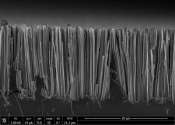Eco-friendly production of silicon nanowires
Physicists from the Lomonosov Moscow State University have worked out a new and more eco-friendly method of obtaining silicon nanowires that replaces hydrofluoric acid (HF) with ammonium fluoride (NH4F).

Physicists from the Lomonosov Moscow State University have worked out a new and more eco-friendly method of obtaining silicon nanowires that replaces hydrofluoric acid (HF) with ammonium fluoride (NH4F).
Nanophysics
Oct 19, 2016
0
0

Combining a sugar derived from crab and shrimp shells with nanomaterials could lead to applications that enhance bone regeneration and wound healing.
Materials Science
Oct 18, 2016
0
1

Silver nanoparticles have a wide array of uses, one of which is to treat drinking water for harmful bacteria and viruses. But do silver nanoparticles also kill off potentially beneficial bacteria or cause other harmful effects ...
Bio & Medicine
Oct 13, 2016
0
7

Structural chemist and chemical crystallographer Dr Alison Edwards has contributed to the characterisation of two large, complex silver nanoclusters of 136 and 374 atoms as part of an international collaboration led by researchers ...
Nanomaterials
Sep 21, 2016
1
12

A senior fellow at the Faculty of Chemistry, MSU, Vladimir Bochenkov, together with his colleagues from Denmark, have established the mechanism of interaction of silver nanoparticles with the cells of the immune system. The ...
Bio & Medicine
Aug 31, 2016
0
1

Changing Australian soil conditions are exposing crops to silver nanoparticles, which are widely used in household products, a study led by The University of Queensland has found.
Environment
Jul 8, 2016
2
34

As a researcher of nanomaterials, I am often asked: "When are we finally going to start seeing nanotechnology products on the market?"
Nanomaterials
Jul 5, 2016
0
27

A team of scientists at Pacific Northwest National Laboratory (PNNL) have demonstrated how any research-grade optical microscope could be used to record spectrally resolved optical images. Their initial demonstration focused ...
Optics & Photonics
Jun 9, 2016
0
28

Anti-odor athletic clothes containing silver nanoparticles have gained a foothold among exercise buffs, but questions have arisen over how safe and effective they are. Now scientists report in ACS' journal Environmental Science ...
Environment
Mar 30, 2016
0
15

More than 2,000 consumer products today contain nanoparticles—particles so small that they are measured in billionths of a meter.
Bio & Medicine
Oct 8, 2015
0
46